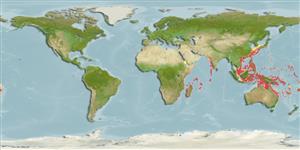Teleostei (teleosts) >
Eupercaria/misc (Various families in series Eupercaria) >
Labridae (Wrasses)
Etymology: rubrovittatus: Named in reference to its two red stripes (Ref. 33414).
More on authors: Randall & Fourmanoir.
Environment: milieu / climate zone / depth range / distribution range
Ecology
Marine; demersal; depth range 50 - 120 m (Ref. 90102). Tropical
Western Central Pacific: New Caledonia, Papua New Guinea, Indonesia, and Palau.
Size / Weight / Age
Maturity: Lm ? range ? - ? cm
Max length : 12.0 cm TL male/unsexed; (Ref. 90102)
Dorsal spines (total): 10; Dorsal soft rays (total): 11; Anal spines: 3; Anal soft rays: 12. Body elongate, depth 6.2-6.3 in SL; head and anterior body cylindrical; eye large, 3.55-4.2 in HL; interorbital space nearly flat, 5.0-5.5 in HL; two pairs of large, well-space, recurved canine teeth anteriorly in each jaw; remaining conical teeth uniserial and small except for canine at corner of mouth; distinctive red-striped pattern consisting of midlateral red stripe from front of lips, faintly through eye, and continuing to end of caudal fin and a narrow red stripe dorsally on head and body.
Body shape (shape guide): elongated.
Deep coastal to outer reef habitats. First found in about 100 m, specimens have since been found much shallower and ranging as far north as Japan. A second new species in the genus was recently found in the Maldives (Ref. 48636). Maximum depth reported taken from Ref. 128797.
Life cycle and mating behavior
Maturity | Reproduction | Spawning | Eggs | Fecundity | Larvae
Oviparous, distinct pairing during breeding (Ref. 205).
Randall, J.E. and P. Fourmanoir, 1998. Terelabrus rubrovittatus, a new genus and species of labrid fish from New Caledonia and New Guinea. Bull. Mar. Sci. 62(1):247-252. (Ref. 33414)
IUCN Red List Status (Ref. 130435: Version 2024-2)
Threat to humans
Harmless
Human uses
Fisheries: of no interest
Tools
Special reports
Download XML
Internet sources
Estimates based on models
Preferred temperature (Ref.
123201): 21.8 - 28, mean 26.5 °C (based on 90 cells).
Phylogenetic diversity index (Ref.
82804): PD
50 = 0.6250 [Uniqueness, from 0.5 = low to 2.0 = high].
Bayesian length-weight: a=0.00490 (0.00204 - 0.01176), b=3.15 (2.94 - 3.36), in cm total length, based on LWR estimates for this (Sub)family-body shape (Ref.
93245).
Trophic level (Ref.
69278): 3.4 ±0.4 se; based on size and trophs of closest relatives
Resilience (Ref.
120179): High, minimum population doubling time less than 15 months (Preliminary K or Fecundity.).
Fishing Vulnerability (Ref.
59153): Low vulnerability (10 of 100).
🛈
